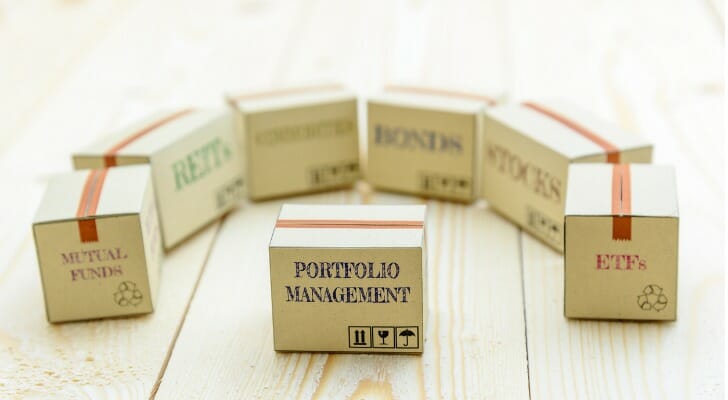Investing in bond funds can diversify your portfolio, but it’s important to understand how they compare to other financial instruments. Like stocks or exchange-traded funds (ETFs), bond funds have unique advantages and disadvantages. They can be a low-cost option with consistent returns, but they also come with some unavoidable risk.
A financial advisor can help you determine which investments belong in your portfolio based on your current financial situation and long-term goals.
What Are Bond Funds?
A bond fund is a mutual fund that includes a mix of different bonds and other debt instruments. Investors pool their money together in a bond fund, the same way they would in a stock mutual fund.
Some bond funds may focus solely on short-term investments. Others are designed for the buy and hold investor. Certain funds may attempt to track a specific market benchmark or index.
Some bond funds are actually exchange-traded funds (ETFs) rather than traditional mutual funds. ETFs trade on an exchange, just like a stock. Compared to regular mutual funds, bond ETFs may have a lower turnover rate. That causes them to be more tax-efficient. ETFs also tend to carry lower management fees.
Types of Bond Funds
There are several broad categories of bond fund investments, including:
- Investment-grade bonds: This includes bonds that have been classified as investment grade by bond rating organizations. These are high-quality bonds and may include Treasury bonds, mortgage-backed securities, corporate bonds and inflation-protected bonds.
- High-yield bonds: The overall goal of high-yield bond funds is to generate income and consistent returns for investors. While these types of bond funds may offer more reward than investment-grade bonds, they also tend to carry more risk.
- Municipal bonds: Municipal bond funds focus solely on municipal or muni bonds. These are bonds linked to local and state government agencies. When a government entity issues a municipal bond, it allows them to raise funds (using the money you invest in the bond) to pay for public projects like bridges or buildings. The chief advantage of municipal bonds is that they can create reliable income without the higher risk profile of high-yield bonds.
- Multisector funds: Multisector bond funds can include a mix of different bond types, with varying risk and reward profiles. For example, you might find high-, low- and intermediate-quality bonds in this type of fund. You might also have a mix or high-yield and municipal bonds.
- International funds: The bond fund types outlined so far focus primarily on U.S. or domestic bonds. With an international bond fund, you get exposure to foreign bonds as well as those issued by U.S. organizations and companies.
Pros of Bond Fund Investing

There are several good reasons to include bond funds as part of your overall investment strategy:
- No or low minimum investment to purchase
- No maturity date to hold for – can sell at any time
- Professional management and decision making as to which issues to buy or sell
- No charges for exchanging shares into other funds in the family
- A systematic purchase program that costs as little as $50
- Lower costs than a typical portfolio of bonds
Bond funds are a good way to diversify your investment portfolio, beyond just holding stocks.
In terms of risk, bonds are comparatively less risky than stocks or mutual funds. While you may not earn a double-digit return with a bond fund the way you might with a stock or ETF, the returns you earn from bonds tend to be more consistent and predictable. That’s important if you’re interested in generating some stable income within your portfolio.
Cons of Bond Fund Investing
One of the biggest drawbacks associated with bond funds is interest rate risk. Generally, when interest rates rise the value of fund shares can diminish. That can reduce returns. Bonds with a longer horizon until maturity are typically more vulnerable to changing interest rates than short-term bond funds.
Credit risk can also be an issue with bonds and bond funds. Bond funds that include more lower-quality holdings tend to carry more credit risk (meaning more risk of default) than high-quality bond funds.
Bond Fund Performance in Different Market Conditions
Bond funds can perform very differently depending on the broader economic environment, so it’s important to understand how various factors influence returns.
Interest Rates
When interest rates rise, bond prices typically fall, which can reduce the value of bond fund shares. Longer-term bond funds tend to be more sensitive to rate changes than short-term funds because their fixed payments are locked in for longer. Conversely, when interest rates decline, bond prices generally rise, often boosting bond fund returns.
Economic Growth and Recession
During periods of strong economic growth, high-yield and corporate bond funds may outperform as companies are less likely to default. However, in a recession, investors often seek safety in higher-quality bonds like Treasuries, causing investment-grade bond funds to hold up better while riskier bond funds may decline.
Inflation
High inflation can erode the real value of bond interest payments, which may weigh on performance, especially for long-term bonds. Treasury Inflation-Protected Securities (TIPS) funds can help offset this risk because their principal value adjusts with inflation.
Federal Reserve Policy
The Federal Reserve’s actions, such as raising or cutting the federal funds rate or engaging in bond-buying programs, can directly impact yields and bond prices. Bond fund investors should pay attention to Fed policy announcements, as they often signal potential shifts in market conditions.
By knowing how bond funds typically react in different environments, you can choose funds that align with your expectations for interest rates, economic growth, and inflation, helping you position your portfolio more strategically.
How to Choose Bond Funds
Selecting bond funds isn’t that different from choosing any other investment. It begins with determining your goals, risk tolerance, and time horizon, as well as the current interest rate environment.
For instance, if rates are rising, you might be more interested in short-term bond funds. Or, if you have decades to go before you retire, the higher return potential of high-yield bonds might be attractive.
When evaluating an individual bond or bond fund, consider focusing on the fundamentals. The bond or fund’s share price, its 30-day yield, and its total return over time are key to its performance. Also pay attention to the types of bonds in your fund and the fund’s credit risk.
Next, decide what percentage of your portfolio should include bonds and bond funds. For example, a 60/40 portfolio is a 60% to 40% split between stocks and bonds. Using the rule of 110, however, you’d subtract your current age from 110 to get the percentages you should allocate to stocks and bonds. So, if you’re 30 years old, the rule of 110 would dictate putting 80% of your portfolio in stocks and the rest in bonds.
Bond Funds and Taxes
Gains from bond funds, like those of any other investment, may be subject to tax. If you’re holding them in your 401(k) or a traditional IRA, taxation would be deferred until you begin making qualified withdrawals. With a Roth IRA, your withdrawals are always tax-free as long as they’re qualified.
But if you hold bond funds in a taxable brokerage account, you’d be subject to capital gains tax if the fund distributes dividend income or capital gains. You’ll also be taxed if you sell the fund at a profit. This typically doesn’t apply to municipal bonds, which are usually tax-exempt.
Bottom Line

Investing in bond funds doesn’t have to be complicated. If you understand how bonds and bond funds work, as well as where they fit in your broader portfolio, they could be a sensible investment. Bond funds can help to offset some of the volatility associated with stock investing while helping you generate income for the short- or long-term.
Tips for Building an Investment Portfolio
- DIY investing is doable in today’s world, but a financial advisor can help you manage your portfolio as it keeps growing. SmartAsset’s free tool matches you with up to three financial advisors who serve your area, and you can interview your advisor matches at no cost to decide which one is right for you. If you’re ready to find an advisor who can help you achieve your financial goals, get started now.
- Whether you’re choosing bonds or any other investment, pay close attention to the fees involved. If you’re investing through a brokerage account, for instance, you may pay a commission fee each time you buy or sell an investment. Fees can add up over time, so it’s important to be aware of what you’re paying.
Photo credit: ©iStock.com/William_Potter, ©iStock.com/izusek, ©iStock.com/xijian
